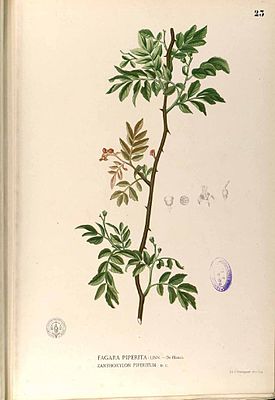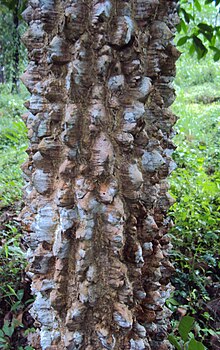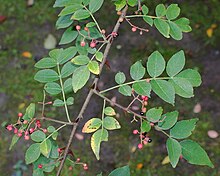Zanthoxylum
| Zanthoxylum | ||||||||||||
|---|---|---|---|---|---|---|---|---|---|---|---|---|

Illustration of Zanthoxylum piperitum |
||||||||||||
| Systematics | ||||||||||||
|
||||||||||||
| Scientific name | ||||||||||||
| Zanthoxylum | ||||||||||||
| L. |
Zanthoxylum is a genus of plants fromthe diamond family (Rutaceae). The direct translation of Zanthoxylum is “yellow wood”, Greek xanthos ξανθός “yellow” and xylon ξύλον “wood”, but several species of plants of different genera are so named, it describes one of the characteristic features, the color of the wood and that some species are used for yellowing were. Much more types arecalled Szechuan pepper , they provide hot-tasting spices that are not related to real pepper ( Piper nigrum ), but to citrus plants ( citrus ). The name Szechuan pepper is derived from the central Chinese province of Sichuan , where some of the types are native and used in the kitchen; As with the province, different spellings such as Sichuan, Sechuan or Szetschuan pepper are used.
description


Appearance and leaves
Zanthoxylum species grow as evergreen or deciduous, climbing or upright shrubs or trees that are often prickly. They contain essential oils and so the bark and leaves in particular have an aromatic smell . Some species have yellowish wood (name).
The alternate leaves are stalked. The leathery or herbaceous leaf blade is compound; it is paired and unpaired pinnate with one to 31 pinnate leaves. The alternate or opposite pinnate leaves on the rachis have only one vein or are pinnate and are often dotted with glands. The leaf margin is smooth to notched. Stipules are present or absent.
Inflorescences and flowers
The small flowers are in differently structured inflorescences together with bracts . The flowers are rarely hermaphroditic or mostly functionally unisex. If the flowers are unisexual, the species are dioeciously separated ( dioecious ) or unisexual and hermaphroditic flowers are on one plant.
The small, fragrant flowers are radially symmetrical to somewhat zygomorphic with double or single perianth . There are either six to ten equally shaped bracts or three, four or five sepals and an equal number of petals . The bracts are mostly yellow-green. There is a ring-shaped disc. Four to six fertile stamens are present in the hermaphrodite and male flowers ; they are all the same or significantly different. Rudimentary stamens may be present or absent in the female flowers . The stamens are mostly more or less fused at their base, but not with the bracts. The hermaphrodite and female flowers contain one to five carpels below , they can be free or fused to form an ovary . There are two ovules per carpel . The one to five styles are completely free or partially fused. The scars are heady. Pollination occurs by insects ( entomophilia ).
Fruits and seeds
The fruits are either follicles that are either free or up to five (corresponding to the number of carpels per flower) are combined in one collective fruit . Or split fruits are formed that disintegrate into one to five partial fruits. The fruits contain one to five egg to spherical seeds.
distribution
The genus Zanthoxylum is pantropical to subtropical. Some species are also found in the temperate latitudes of eastern Asia and eastern North America. There are 41 species in China, 25 of which are endemic there. Some species are grown as crops.
Systematics
Zanthoxylum belongs to the subfamily of Toddalioideae in the family of Rutaceae (Rutaceae). Synonyms for Zanthoxylum L. are: Fagara L. , Ochroxylum Schreb. , Xanthoxylum Mill. Orth. Var.
There are around 200 to 250 Zanthoxylum species (selection):
- Zanthoxylum acanthopodium DC. : Home: China and Tropical Asia
- Zanthoxylum ailanthoides sieve. & Zucc. : Home of Japan and Taiwan.
- Toothache wood ( Zanthoxylum americanum Mill. ): Native to eastern North America.
- Nepalese Sichuan pepper ( Zanthoxylum armatum DC. ): Origin : tropical and temperate South and East Asia
- Zanthoxylum austrosinense C.C. Huang : Origin: China
- Zanthoxylum avicennae (Lam.) DC. : It was described from China.
- Zanthoxylum bungeanum Maxim. : Home: China and Bhutan
- Zanthoxylum calcicola C.C. Huang : Endemic to China
- Zanthoxylum clava-herculis L .: native Caribbean.
- Zanthoxylum coco Gillies ex Hook. & Arn. : Home: Bolivia and Argentina
- Zanthoxylum collinsiae Craib : Origin: Indochina
- Zanthoxylum coreanum Nakai : native Korea.
- Zanthoxylum decaryi H.Perrier : Endemic to Madagascar .
- Zanthoxylum dimorphophyllum Hemsley : It was described from China.
- Zanthoxylum dipetalum H. Mann : Origin : Hawaii
- Zanthoxylum dissitum Hemsley : Endemic to China
- Zanthoxylum echinocarpum Hemsley : Endemic to China
- Zanthoxylum esquirolii H.Léveillé : Endemic to China
- Zanthoxylum fagara (L.) coffin. : Home: South and Central America, USA (Florida, Texas)
- West Indian Satinwood ( Zanthoxylum flavum Vahl ): Origin: Caribbean Islands, USA (Florida)
- African satinwood ( Zanthoxylum gilletii (De Wild.) PG Waterman ): Origin: tropical Africa
- Zanthoxylum glomeratum C.C. Huang : Endemic to China
- Zanthoxylum hawaiiense Hillebr. : Home: Hawaii
- Zanthoxylum heitzii (Aubrév. & Pellegr.) PGWaterman : From Central Africa
- Zanthoxylum hirsutum Buckley : Origin: Mexico, USA (Oklahoma, Texas)
- Zanthoxylum hyemale A.St.-Hil. : Home: South America (Brazil, Argentina, Paraguay, Uruguay)
- Zanthoxylum integrifoliolum (Merrill) Merrill : Origin: Philippines
- Zanthoxylum khasianum J.D. Hooker : Origin : Himalayas
- Zanthoxylum kwangsiense (Handel-Mazzetti) Chun ex CCHuang : Endemic to China
- Zanthoxylum laetum Drake : Origin: China, North Vietnam
- Zanthoxylum leiboicum C.C. Huang : Endemic to China
- Zanthoxylum liboense C.C. Huang : Endemic to China
- Zanthoxylum macranthum (Handel-Mazzetti) CCHuang : Endemic to China
- Zanthoxylum madagascariense Baker : Endemic to Madagascar.
- Zanthoxylum mananarense H.Perrier : Endemic to Madagascar.
- Zanthoxylum martinicense (Lam.) DC. : Home: Caribbean Islands, Venezuela
- Zanthoxylum micranthum Hemsley : Endemic to China
- Zanthoxylum molle Rehder : Endemic to China
- Zanthoxylum motuoense C.C. Huang : Endemic to China
- Zanthoxylum multijugum Franchet : Endemic to China
- Zanthoxylum myriacanthum Wall. ex Hook. f. : Home: from India to the Philippines and China
- Zanthoxylum naranjillo Griseb. : Home: South America (Bolivia, Brazil, Argentina, Paraguay, Uruguay)
- Zanthoxylum nitidum (Roxb.) DC. : Home: Asia, New Guinea and Australia
- Zanthoxylum ovalifolium Wight : Origin: South Asia, New Guinea and Australia
- Zanthoxylum oxyphyllum Edgew. : Home: China, Bhutan, India, Nepal, Myanmar
- Zanthoxylum panamense P.Wilson : Origin: Central America (Belize, Costa Rica, Guatemala, Nicaragua, Panama)
- Zanthoxylum parvum Shinners : Homeland: Texas
- Zanthoxylum piasezkii Maxim. : Native to southern Gansu, western Henan, southern Shaanxi and Sichuan at altitudes of 1700 to 2500 meters.
- Zanthoxylum pilosulum Rehder & EHWilson : Native to southern Gansu, southern Shaanxi, Yunnan, northeastern and western Sichuan at altitudes between 2500 and 3100 meters.
- Chinese Sichuan pepper , Japanese pepper or Szechuan pepper ( Zanthoxylum piperitum (L.) DC. )
- Zanthoxylum planispinum sieve. & Zucc. : Home to Japan, Korea, Taiwan and China.
- Zanthoxylum pteracanthum Rehder & EHWilson : Endemic in western Hubei (Xingshan) at an altitude of about 1000 meters.
- Zanthoxylum rhetsa (Roxb.) DC. : Home: India, Bangladesh, Sri Lanka, Myanmar, Thailand, Vietnam, Malaysia, Indonesia, New Guinea, Philippines
- Zanthoxylum rhombifoliolatum C.C. Huang : Native to Chongqing and Guizhou at altitudes between 500 and 1000 meters.
- Zanthoxylum scandens flower : native to China, Taiwan, India, Indonesia, Japan (Ryukyu Islands), Malaysia and Myanmar.
- Zanthoxylum schinifolium sieve. & Zucc. : Home to China, Japan (including the Ryukyu Islands) and Korea.
- Deceptive yellowwood or deceptive prickly ash ( Zanthoxylum simulans Hance ): native to China.
- Zanthoxylum stenophyllum Hemsl. : Native to southern Gansu (Chengxian, Huixian), western Henan, western Hubei, northeastern Hunan, southwestern Shaanxi, Sichuan at altitudes between 700 and 2400 meters.
- Zanthoxylum stipitatum C.C. Huang : Native to northwestern Fujian, northern Guangdong, northeastern Guangxi and southern Hunan at altitudes between 100 and 800 meters.
- Zanthoxylum subspicatum H.Perrier : Endemic to Madagascar.
- Zanthoxylum thomasianum (Krug & Urb.) Krug & Urb. ex P.Wilson : Home: Puerto Rico and Virgin Islands
- Zanthoxylum thouvenotii H.Perrier : Endemic to Madagascar.
- Zanthoxylum tomentellum J.D.Hooker : native to Yunnan, Bhutan, northeastern India, Myanmar and Nepal.
- Zanthoxylum tsihanimposa H.Perrier : Endemic to Madagascar.
- Zanthoxylum undulatifolium Hemsley : Native to western Hubei, southern Shaanxi, eastern Sichuan and northeastern Yunnan at altitudes between 1,600 and 3,200 meters.
- Zanthoxylum wutaiense I.S.Chen : Endemic to Taiwan at altitudes between 1300 and 1400 meters.
- Zanthoxylum xichouense C.C. Huang : Endemic to southeastern Yunnan at altitudes between 1400 and 1500 meters.
- Zanthoxylum yuanjiangense C.C. Huang : Endemic to southern Yunnan at altitudes between 400 and 600 meters.
- Zanthoxylum zanthoxyloides (Lam.) Zepern. & Timler : Home: tropical West Africa.
No longer belong to the genus:
- Zanthoxylum daniellii Benn. ⇒ Tetradium daniellii (Benn.) TGHartley
- Zanthoxylum pteleifolium Champ. ex Benth. ⇒ Melicope pteleifolia (Champ. Ex Benth.) TG Hartley
- Zanthoxylum roxburghianum Cham. ⇒ Melicope lunu-ankenda (Gaertn.) TG Hartley
- Zanthoxylum trifoliatum L. ⇒ Eleutherococcus trifoliatus (L.) SYHu
use
In addition to the uses already mentioned as a spice or for yellowing, Zanthoxylum species are also used medicinally, for example as disinfecting toothbrushes in Africa or as components of toothpaste, are also part of traditional Chinese medicine.
Chemical ingredients
(1 S , 5 S ) - (-) - Sabinen occurs in the Indian medicinal plant Zanthoxylum rhetsa .
swell
- HR Coleman: Zanthoxylum in the Western Australian Flora : Online, 2008.
- Dianxiang Zhang & Thomas G. Hartley: Zanthoxylum in der Flora of China, Volume 11, p. 53: Online.
Individual evidence
- ^ A b Zanthoxylum in the Germplasm Resources Information Network (GRIN), USDA , ARS , National Genetic Resources Program. National Germplasm Resources Laboratory, Beltsville, Maryland. Retrieved October 19, 2013
- ↑ Entry on Thujene. In: Römpp Online . Georg Thieme Verlag, accessed on March 2, 2012.








